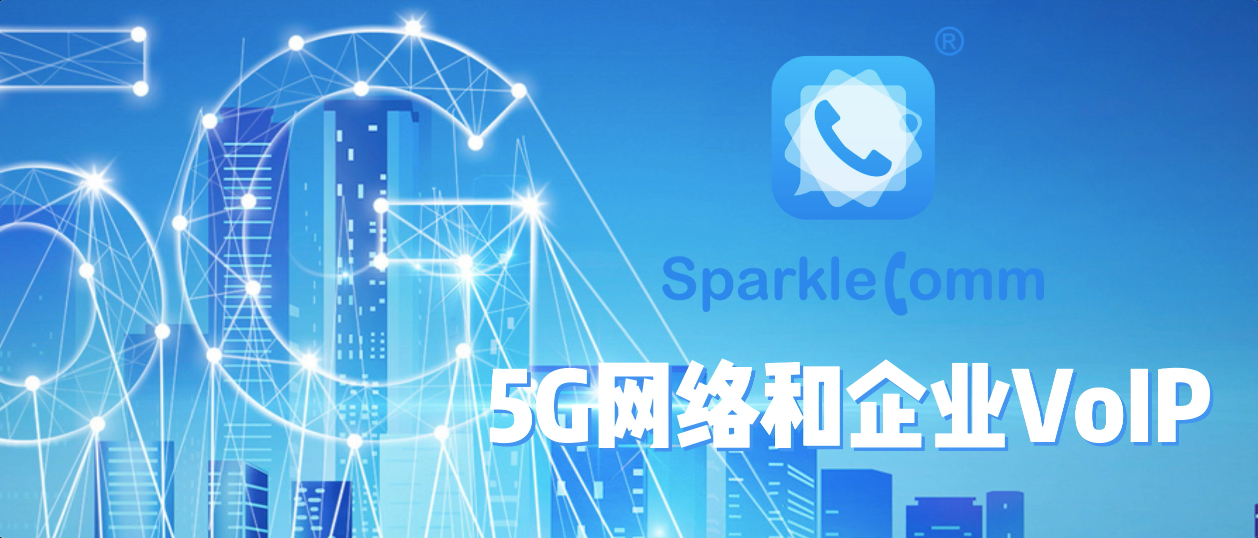At present, the discussion about ultra-high-speed connectivity and the high capacity of 5G networks is no longer the headlines, but research and development for 5G applications and application levels remains the focus of attention. Because speed and coverage are far from universal, most consumers still think that 4G networks are the normal communication standard. This begs the question, if 4G networks are the end of the world, why is it still the mainstream of communications, and everyone is inexplicably excited about the arrival of 5G?
5G networks with enterprise sparkleComm VoIP
This discussion is particularly relevant to the VoIP industry. While many vendors offer HD Voice services, this is not the default option for most scenarios, some telecom operators offer LTE-based voice capabilities, and enterprise users often need to upgrade to get high-quality audio on their phones.

The discussion of ultra-high-speed connectivity and the high capacity of 5G networks is no longer headlines
For telecom operators, building 5G networks between SwingeComm VoIP service providers, handset makers, and other entities involved in the ecosystem is really exciting.
Let's first understand what 5G is and what benefits 5G can bring to VoIP
From 1G to 5G
First, what exactly does 5G mean? G stands for Generation Wireless Technology. Therefore, 5G is the fifth generation of wireless technology launched by operators to date. The first generation consisted of analog cellular connectivity technology. 2G technologies such as CDMA and GSM are the first generation of digital connectivity. Many of us remember moving to 3G technology, which brought faster network connections to small devices like smartphones. 3G enables phones and tablets to browse the internet anytime, anywhere.
With the advent of 4G LTE, mobile devices are beginning to replace desktops and laptops as the preferred way to access websites. Users can access it at 100-megabit speeds through 4G networks. For some customers, their cellular LTE speeds can easily surpass home broadband! Each generation of wireless technology is incompatible with the previous generation for a variety of reasons, and 5G networks continue to maintain the same trend.
What does 5G bring to VoIP?
Without going into technical details, signals of higher frequencies will be used compared to 4G networks. This new band will have less congestion, allowing more devices to join the growing network usage. Even if 5G has not yet reached its peak, 5G will be much faster than 4G.
But the benefits of 5G aren't limited to speed. While each generation of wireless cellular technology promises faster speeds, 5G brings more benefits:
Faster
Has lower latency
Ability to connect more devices
5G and SparkleComm VoIP with low latency
Network communication speed is a must for modern networks. Consumer expectations for data connection speeds are rising – which is why 5G is exciting. Whenever carriers seem to be able to meet expected expectations, new applications emerge that require faster connectivity. For example, while 3G is fast, it's still not enough to support a wide range of video chats. With the advent of 4G, consumers need to connect at a higher speed to achieve high-definition and lag-free video conferencing! As expected, 5G speeds will be much faster than the 4G speeds we've seen so far.
The real benefit of 5G for VoIP is that it has low latency
But the real benefit of 5G for The SparkleComm VoIP is that it has low latency. SparkleCommVoIP is real-time communication, which means that latency is just as important as network speed. 4G networks typically have latencies from 40ms to 60ms, while 5G can reduce it to 10 milliseconds or less! This is a very good improvement and very important for The SparkleComm VoIP.
5G networks also have the ability to handle more devices more efficiently. This will become crucial as the Internet of Things continues to evolve. Current networks are not designed to handle billions of IoT devices, many of which are sensors that are constantly sending data to the cloud and vice versa.
5G – Reality or Dream?
Since the signal cannot travel very far, this makes the 5G network still problematic. To deliver faster speeds, low latency, and high capacity, 5G requires access points closer to each other than 4G. Experts predict that in dense urban areas, access points may have to be built in roofs, lampposts, or even bricks of new construction!
All of this requires operators to invest heavily in network infrastructure. Obviously, 5G has brought clear benefits to consumers and software developers, but network construction needs to have a clear path to profitability. And now many of the benefits of 5G are cutting-edge, in other words, we rarely see or use it in our daily lives. Of course, autonomous driving requires 5G, but relying on this alone is not enough to form an incentive for operators to invest.
Advances in time and communication technologies will eventually push 5G out of its dreams or be replaced by new ones. Some people have expected that 5G will become "commonplace" by 2021, but the truth is that "commonplace" may not be commonplace. But what about in the long run? Can 5G become the new normal for applications?